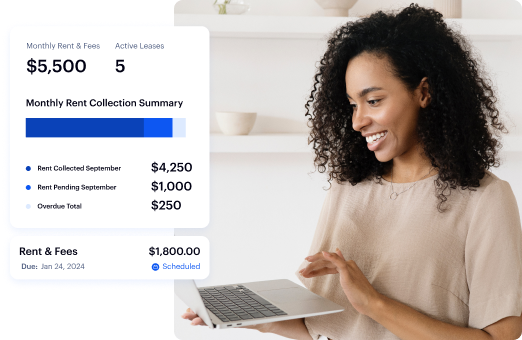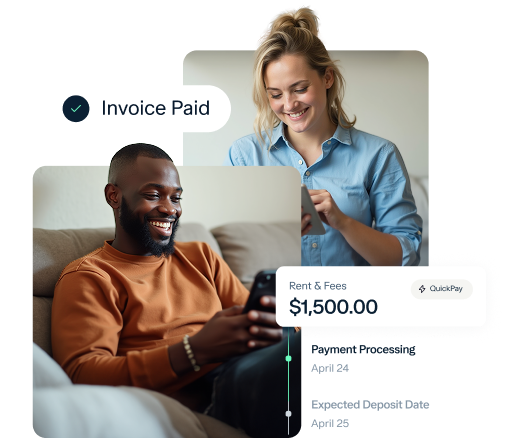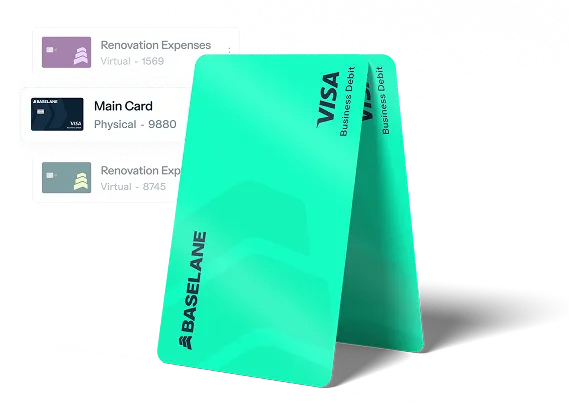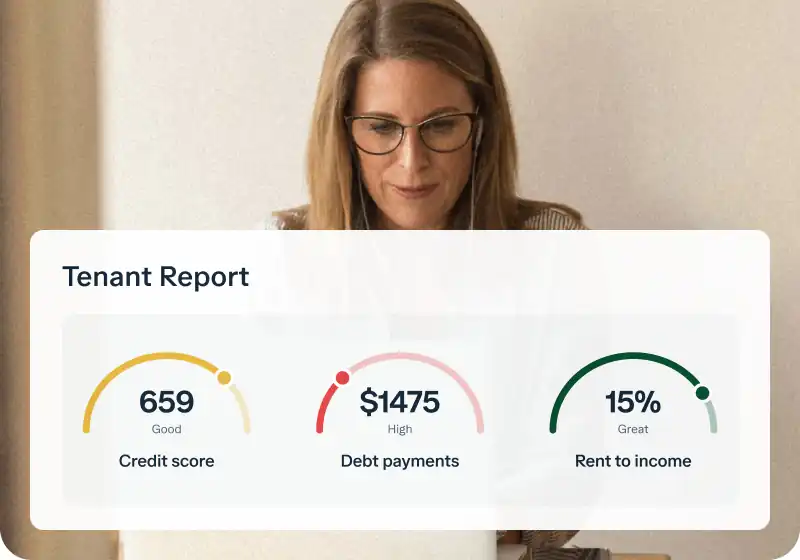Collecting rent efficiently is key to running a smooth rental business. ACH payments (Automated Clearing House) let landlords move money directly between bank accounts securely, reliably, and with lower fees than credit cards or checks.
This guide breaks down how ACH works, how to set it up, and why it's a smart choice for landlords managing rent collection.
Key takeaways
- ACH payments transfer funds electronically between bank accounts via the ACH network.
- To receive ACH payments, you typically only need to provide your bank routing and account numbers.
- Landlords can receive rent payments efficiently using ACH via specialized platforms.
- Standard ACH payments take 1-2 business days, while Same Day ACH is faster but may cost more.
- Receiving ACH payments generally involves low per-transaction fees compared to other methods.
How do receiving ACH payments work?
ACH payments involve two main types of transactions to get money into your account:
- ACH Credits (money pushed into your account): This is when the payer (your tenant) initiates the transfer from their bank to yours.
- ACH Debits (money pulled from someone else's account with permission): This is when you (or your rent collection platform) initiate a withdrawal from the tenant's account after they've given you authorization.
Regardless of whether the money is "pushed" or "pulled," the transfer is processed in batches by clearing houses like the Federal Reserve. The sending bank (Originating Depository Financial Institution or ODFI) starts the transfer, and the receiving bank (Receiving Depository Financial Institution or RDFI) deposits the funds into your account.
This system is popular because it’s a reliable, secure, and fast way to manage rent collection, especially with specialized property management software
The benefits of accepting ACH payments
ACH is often considered the best way to collect rent from tenants because it solves many common problems associated with older payment methods:
- Low fees: ACH transactions are significantly cheaper per transfer compared to credit card payments, helping you maximize your profit.
- Reliability for recurring payments: Tenants are less likely to change bank accounts than credit cards, reducing payment failures and helping maintain reliable cash flow for regular payments like rent.
- Automation potential: It’s easy to set up automated, recurring payments through platforms like Baselane, eliminating the manual task of chasing down rent every month.
- Increased cash flow predictability: Scheduled, automated ACH payments give you a clearer forecast of your rental income, which is crucial for financial planning and growing your portfolio.
- Security: Transfers occur directly between banks, making them a secure method for moving funds.
Two ways to receive ACH payments
When you get paid via ACH, it's either an ACH Credit (pushed by the tenant) or an ACH Debit (pulled by you or your platform). Both methods result in a deposit to your account, but the process is different.
Receiving ACH credit (push)
An ACH Credit is when your tenant initiates the transfer to your account. This is often what people simply call "direct deposit".
To receive it, you need to give the tenant your bank's routing number and your specific account number. The tenant then uses this information to instruct their bank to push the funds directly into your account. You don't need to do anything after providing your details; the ACH network handles the rest, and funds are deposited according to standard processing times.
Receiving ACH debit (pull)
An ACH Debit is when you, or a service provider on your behalf (like a rent collection platform), initiates a withdrawal from the tenant's bank account. This is often the more convenient method for collecting recurring rent payments.
For this to happen, you must first get authorization from the tenant to withdraw funds. This authorization grants you permission for future debits up to the agreed-upon lease terms. Once authorized, your payment processor can automatically initiate the debit request on the due date. This makes for a more efficient system for recurring payments like rent.
How to receive ACH credit payments from Tenants
The most efficient and dependable way to collect rent via ACH is by using a dedicated, landlord-focused platform. You want a tool that streamlines this process for both you and your tenants.
Specialized platforms for landlords do the following:
- Handle the setup: They manage the authorization process and initiate the debit from the tenant's account on the due date.
- Offer a clear audit trail: They provide a clear record of the rent roll and track payments.
- Automate payments: Tenants can set up automatic payments directly from their bank account, which drastically reduces late or missed payments.
Baselane’s banking platform offers integrated rent collection, making it super easy for you to start receiving ACH payments at minimal fees.
Here’s how Baselane supercharges your ACH rent collection:
- Automated Rent Collection: You set the rent amount, fees, and due dates, and Baselane sends automated invoices and reminders to tenants. Tenants can easily set up tenant auto-pay directly from their bank account via ACH, guaranteeing timely payments and minimizing the stress of chasing rent.
- Direct-to-Bank Deposits: Rent payments are deposited directly into your linked Baselane accounts (or an external account), which are FDIC insured up to [v="fdic_short"]¹ for funds deposited through Thread Bank; Member FDIC. Certain conditions must be satisfied for pass-through deposit insurance coverage to apply.
- Seamless Bookkeeping: When rent hits your account, the transaction is automatically categorized and tagged by property and 120+ Schedule E categories. This saves you time on manual data entry and ensures that your financial records are accurate and tax-ready.
If you're interested in alternative payment methods, remember that collecting rent via credit card is an option, but it typically involves higher fees. Learn more: How to pay rent with a credit card.
Want more advice? Check out these rent collection tips to improve on-time payments and reduce late fees.
ACH payment processing: How long does it take?
Unlike instant payment methods like wire transfers, ACH payments are processed in batches. It increases the Standard ACH receivable settlement time between 1-2 business days.
For example, if the tenant initiates a rent payment on Monday, it will likely arrive in your account by Tuesday or Wednesday. Business days exclude weekends and federal holidays, which affect processing times.
Same Day ACH is an option to expedite the payment process. It’s a service that allows payments to settle on the same business day. However, this often comes with a higher processing fee for the initiator or potentially the receiver, depending on the platform used.
Not all banks or platforms support Same Day ACH for all transaction types. Therefore, it's important to manage expectations regarding payment speed when using ACH.
Costs of receiving ACH payments
Typical per-transaction costs for receiving ACH payments are often between $0.20 $1.50. The range might vary depending on the payment processor you use. Stripe,. For example, Stripe caps ACH payment processing fees at $5.
Baselane charges $2 for receiving an ACH payment, but you can waive this fee if you accept the payment in a Baselane bank account instead of an external one. It means you can receive ACH fee-free when you operate your real estate banking with Baselane.
Start accepting ACH payments with Baselane
ACH payments stand out as one of the best rent collection methods for their cost-efficiency and ease of automation.
To make this process even easier, use Baselane’s built-in rent collection solution to receive ACH payments through a secure network. You'll benefit from automated reminders and late fees to reduce chasing payments, and automatic transaction tagging that saves you hours on manual bookkeeping and gets you tax-ready faster
FAQs
What is an ACH payment?
An ACH payment is an electronic money transfer processed through the Automated Clearing House network in the United States. It allows funds to move directly between bank accounts, commonly used for direct deposit and bill payments.
How do I provide information to receive an ACH payment?
To receive an ACH payment, you typically need to give the sender your bank's routing number and your specific bank account number. You can find these numbers on a check or through your online banking portal.
How long does it take to receive funds via ACH?
Standard ACH payments usually take 1 to 2 business days to settle and for funds to become available in your account. Same Day ACH is faster but may not always be available or could cost more.
Can I receive ACH Payments instantly?
Standard ACH payments are not instant. They settle within 1-2 business days due to the batch processing system. While same-day ACH exists and allows for faster settlement, it is not universally supported for all transaction types and may incur additional fees.
How does prorated rent work?
Prorated rent means charging tenants only for the days they occupy a unit during a partial month. For example, if a tenant moves in on the 10th of the month, you charge rent based on the remaining days. Most rent collection platforms can calculate this automatically.
Is receiving ACH payments safe?
Yes, an ACH transfer between bank accounts is generally considered a safe method for transferring funds. The ACH network is operated and regulated by NACHA, which sets strict rules and standards for financial institutions. These rules help protect both senders and receivers.

















